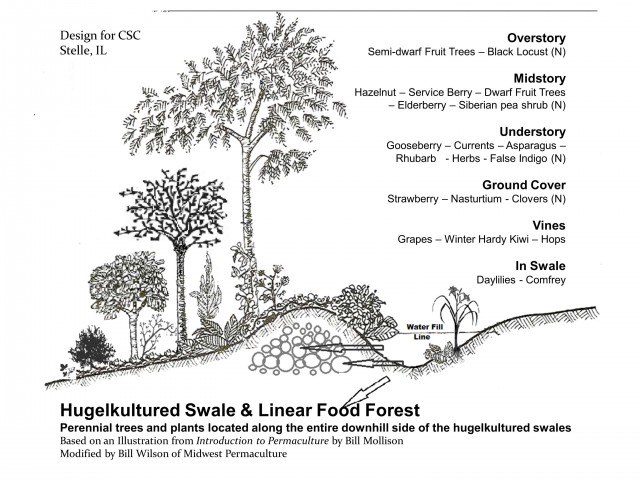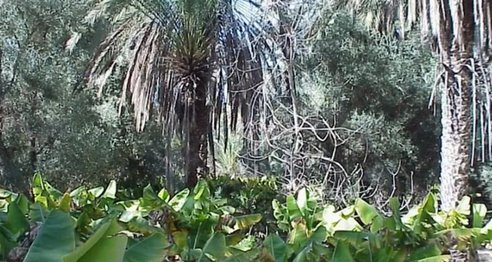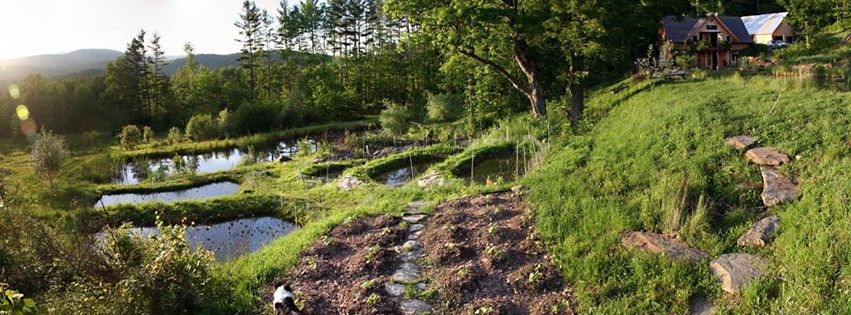 Introduction:
Introduction:
"Permaculture" is an agricultural and social design system that is centred around creating sustainable and regenerative human habitats. The term "permaculture" was coined in the 1970’s by Bill Mollison and David Holmgren in Australia, who saw the need for a more sustainable approach to agriculture and human habitation. However this concept has been demonstrated in many places around the World. Geoff Lawton, another great proponent of Permaculture, stumbled upon a 2000 year old example in Morocco, near the tiny village of INRAREN. Geoff, who was only 21 at the time, explains:
"The air felt cool, almost misty. Growing in the shade of tall date palms were trees, vines, and shrubs bearing bananas, tamarinds, oranges, figs, guavas, pomegranates, lemons, limes, mulberries, carobs, quince, grapes, and other fruits and nuts. Following a footpath through the grassy understory past groves of olive and argan trees, Lawton discovered a cluster of fenced-in vegetable and herb gardens—most about a quarter-acre in size."
"Here and there, goats were tethered to posts. Chickens clucked through the underbrush and roosted in trees. Gazing down a leafy corridor, he spotted a man leading a donkey. Its saddlebags brimmed with produce."
Regarding what Goeff had found all those years ago: Totaling about 65 acres, the food forest was a remnant of one of the world’s oldest sustainable systems of agriculture. While its origins have been lost to history, scientists agree it is at least many centuries old. Some, including Lawton, date its establishment to 2,000 years ago. When asked about the forest’s age, villagers shrug.
 “I have no idea how old it is or when our ancestors first began gardening here,” says 45-year-old Abdelmajid Ziyani, a construction worker and member of a local argan and olive oil cooperative. “But I know it has been here for centuries.”
“I have no idea how old it is or when our ancestors first began gardening here,” says 45-year-old Abdelmajid Ziyani, a construction worker and member of a local argan and olive oil cooperative. “But I know it has been here for centuries.”
“It is really old,” adds 28-year-old Brahim Jidi, with a laugh. He works as a waiter in a local hotel and gardens in the forest as a hobby. He says he grew up hearing stories about his “grand- grand-grandfather” helping tend the forest.
In the 1970s, the communal space was “farmed” by about 800 villagers. Fed by underground springs and shaped by human hands since time immemorial, it was the image of a true oasis. The system remains in use today.
Now 65, Lawton describes his experience at Inraren as life changing, and he has spent a career growing food forests and advocating for their importance as a solution to climate change and other environmental ills. But back in 1975, his friends were threatening to leave him in the woods. Snagging a few oranges, he split. By the time the group reached Paradise Valley, the forest seemed like ancient news.
Permaculture has since become a worldwide movement, with practitioners in over 120 countries. This research paper explores the principles and design aspects of permaculture, including its history, philosophy, and practical applications. Permaculture is a sustainable design system that provides a practical and ethical approach to land use, agriculture, and community-building. It aims to create a harmonious relationship between humans and nature by using principles that focus on working with natural ecosystems. The following research paper explores the principles and design aspects of permaculture and the benefits it offers for sustainable living.
History:
"Permaculture" originated in the 1970’s in Australia, where Bill Mollison and David Holmgren developed the concept. Mollison was a wildlife biologist and Holmgren was a graduate student studying environmental design. Together, they developed a set of design principles that emphasized sustainable agriculture, renewable energy, and natural building materials. In 1978, Mollison published a book called "Permaculture One," which introduced the concept of permaculture to a wider audience.
Philosophy:
The philosophy of permaculture is centred around three core principles: care for the earth, care for people, and fair share. The first principle, care for the earth, emphasizes the need to work with nature rather than against it. This means designing systems that are sustainable, regenerative, and supportive of the natural environment. The second principle, care for people, recognizes the importance of social sustainability. This means creating systems that are socially just, equitable, and empowering for all people. The third principle, fair share, emphasizes the need to share resources and surplus fairly among all people and living beings.
Principles:
Permaculture is guided by a set of twelve principles, which provide a framework for sustainable design. Permaculture is also based on three 'core' concepts: care for the earth, care for people, and fair share. These principles guide the design and implementation of permaculture systems and ensure that they are sustainable, equitable, and resilient. The principles of permaculture are as follows:
- Observe and interact: This principle emphasizes the need to observe and understand the natural environment before designing any systems.
- Catch and store energy: This principle emphasizes the importance of renewable energy sources, such as solar and wind power.
- Obtain a yield: This principle emphasizes the need to design systems that provide a useful yield, whether it be food, energy, or other resources.
- Apply self-regulation and accept feedback: This principle emphasizes the need to design systems that are self-regulating and responsive to feedback from the environment.
- Use and value renewable resources and services: This principle emphasizes the importance of using renewable resources, such as water and soil, and valuing the ecosystem services they provide.
- Produce no waste: This principle emphasizes the need to design systems that minimize waste and create closed-loop systems.
- Design from patterns to details: This principle emphasizes the need to design systems that are informed by the patterns and rhythms of nature.
- Integrate rather than segregate: This principle emphasizes the need to design systems that integrate different elements, rather than segregating them.
- Use small and slow solutions: This principle emphasizes the need to design systems that are small-scale and slow-growing, rather than large-scale and fast-growing.
- Use and value diversity: This principle emphasizes the importance of ‘biodiversity’ and designing systems that are resilient and adaptable.
- Use edges and value the marginal: This principle emphasizes the importance of designing systems that take advantage of edges and marginal spaces, where persity and productivity can be maximized.
- Creatively use and respond to change: This principle emphasizes the need to design systems that are flexible and responsive to changing conditions.
 Design Aspects:
Design Aspects:
Permaculture design is centred around creating sustainable and regenerative human habitats. This involves designing systems that are ecologically sound, socially just, and economically viable. Design also focuses on creating sustainable, resilient, and productive systems that work in harmony with natural ecosystems. The following are some of the key design aspects of permaculture:
- Agroforestry: This involves integrating trees and crops to create productive and sustainable ecosystems.
- Water harvesting: Permaculture systems aim to capture and store rainwater for use in irrigation and other purposes.
- Soil building: Permaculture systems prioritize building healthy soil by using composting, cover cropping, and other techniques.
- Animal husbandry: Permaculture systems can incorporate animals such as chickens, goats, and bees, which can provide food, fertilizer, and other benefits.
- Food forests: These are diverse ecosystems that incorporate a variety of edible plants, trees, and shrubs.
- Renewable energy: Permaculture systems prioritize the use of renewable energy sources such as solar and wind power.
- Community building: Permaculture systems aim to create strong and resilient communities that work together to create sustainable systems.
Site analysis:
This involves assessing the natural environment, including soil type, topography, potential rainfall etc.
- Increased food security: Permaculture systems can produce a variety of foods, including fruits, vegetables, grains, and animal products, which can improve food security for individuals and communities.
- Reduced environmental impact: Permaculture systems prioritize the use of renewable resources and minimize waste, which can reduce the environmental impact of food production.
- Improved soil health: Permaculture systems prioritize building healthy soil, which can improve soil fertility, water retention, and nutrient cycling.
- Increased biodiversity:
Permaculture systems aim to create
Permaculture systems aim to create sustainable and self-sufficient food production systems that work in harmony with nature. Permaculture is a holistic design system that is based on three core ethics: earth care, people care, and fair share. Permaculture systems aim to create a closed-loop system that minimizes waste and maximizes resource efficiency. This is achieved through a range of design principles, including:
- Observation: Permaculture systems begin with careful observation of the natural environment, to understand the interactions between different plants and animals, and to identify the resources and potential constraints of the site.
- Diversity: Permaculture systems promote biodiversity, by incorporating a range of plants, animals, and microorganisms that work together to create a resilient and productive ecosystem.
- Integration: Permaculture systems aim to integrate different components of the ecosystem, such as crops, animals, and water management systems, to create a self-sufficient and regenerative system.
- Natural patterns: Permaculture systems aim to mimic the patterns found in natural ecosystems, such as the flow of water, the cycling of nutrients, and the succession of different plant communities.
- Energy efficiency: Permaculture systems aim to minimize energy inputs by using passive solar design, natural ventilation, and other techniques that reduce the need for artificial heating and cooling.
Overall, Permaculture systems aim to create a sustainable and self-sufficient food production system that works in harmony with nature. By incorporating ecological principles and design techniques, Permaculture systems can help to create more resilient and regenerative ecosystems that provide a range of environmental, social, and economic benefits.
